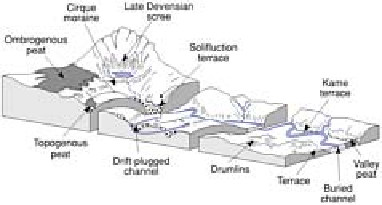Environmental Engineering Reference
In-Depth Information
piedmont fans
10
2-4
km
2
in area, or arid-zone bajadas (Plate 14.13). Much of the later
Cenozoic
molasse
south of the Himalayan mountain front was formed in the former way.
Most temperate catchments reflect the geomorphic impact of Pleistocene cold stages.
Glacial excavation of deep valleys and permafrost ornamentation of slopes in upper
catchments disrupted the fluvial landsystem (see Chapters 15 and 25). Glacial diversion
of drainage and sedimentation altered drainage networks in lowland catchments. High
spring glacial or permafrost meltwater discharge eroded enlarged valleys. They survive as
dry valleys
or are occupied now by diminutive
misfit streams
, especially in normally
porous lithologies such as the chalk and limestone dominating the uplands of south-east
Britain. Altered catchment slope and sediment dynamics still influence fluvial processes
in most areas today (Figure 14.19).
Lakes represent a further, transient interruption of fluvial development of the
catchment. They occur where downstream flow is impeded by rock or debris barriers and
are not exclusive to upper catchment areas. Confining valley slopes create favourable
sites for impounding water after glacial excavation, landslide activity and volcano-
tectonic uplift. The vast lowland lake systems of north-west Canada and eastern
Scandinavia, and the Great Lakes of North America, are largely glacial in origin. Lakes
are both fed and drained by rivers but they buffer downstream stretches from sediment
influx, which progressively infills the basin instead, and also form temporary base levels
for upstream reaches (Figure 14.20).
LOWER CATCHMENTS AND ALLUVIAL CHANNELS
Higher potential energy, leading to net denudation in upper catchment areas, transfers
large sediment volumes into the lower catchment, where they line channels and entire
valley floors with
alluvium
. This is mostly the
Figure 14.19
The geomorphic impact of Pleistocene cold
stages on upland catchments. Modern rivers rework a
landform and sediment system largely not of their making.
Source: Newson (1981).

